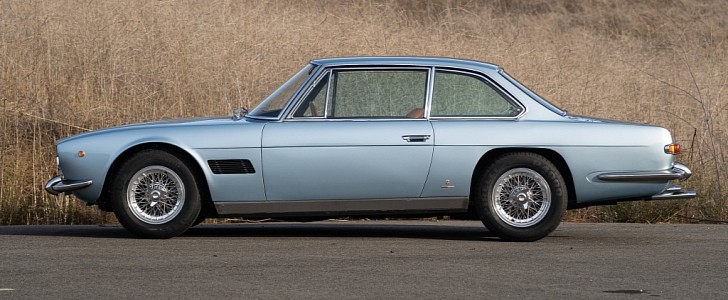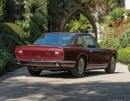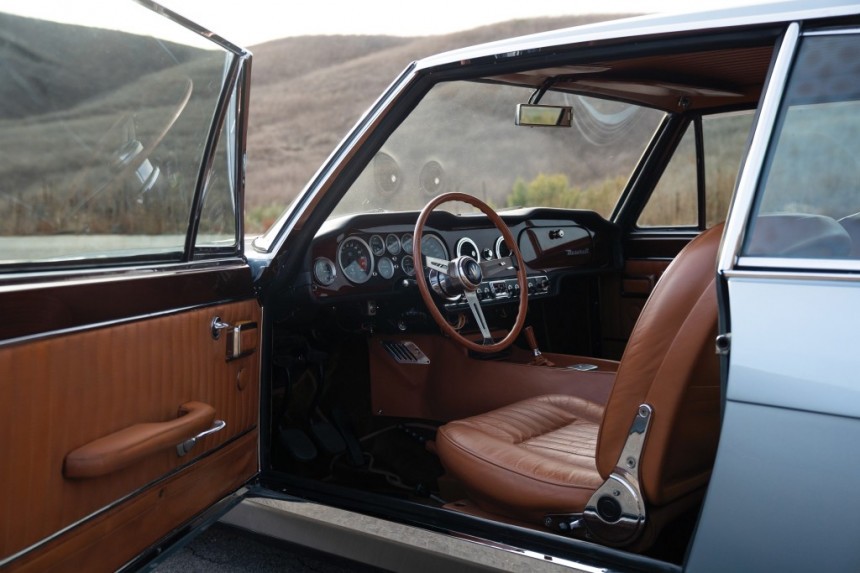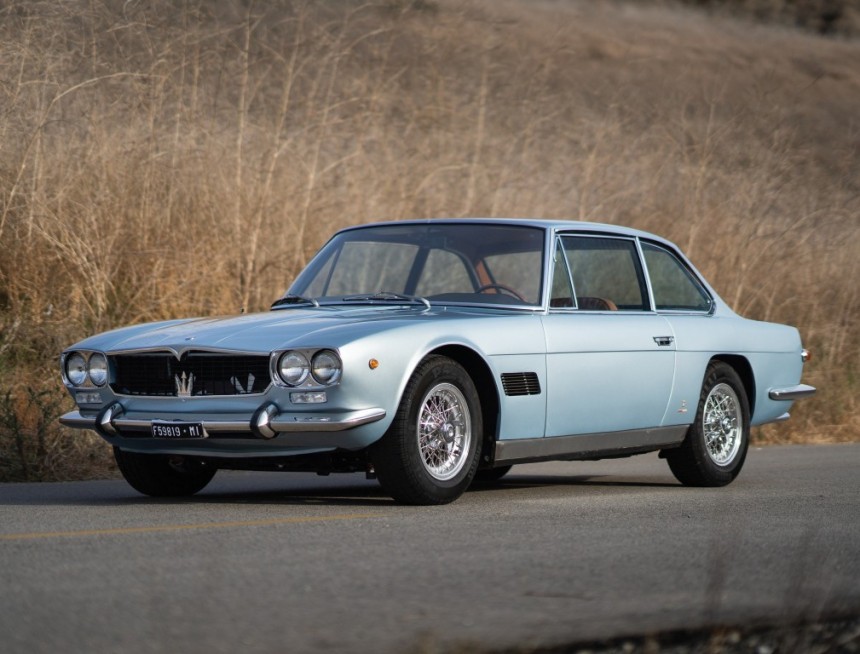1960s Italian grand tourer. What’s the first car that comes to mind? Most enthusiasts would say Ferrari 250 series, which all feature 3.0-liter V12 mills from the Colombo and Lampredi families. Sporting two fewer cylinders but a larger displacement, the Maserati Mexico was the V8-engined alternative to all those marvelous 250s from that bygone era.
The story of this underrated machine starts with 5000 GT chassis number 103.022, one of 22 units finished with Carrozzeria Allemano bodywork. Shipped to Mexican president Adolfo Lopez Mateos, that car was crashed in 1965 between Puebla and Mexico City on the 150D federal highway.
Turin-based Carrozzeria Vignale, which used to be a proper coachbuilder long before the Ford Motor Company spun it off into an upscale sub-brand, was tasked with rebodying the vehicle just in time for the 1965 Turin Motor Show. Also exhibited at the Geneva Motor Show the following year, the rebodied car caught the attention of Maserati’s high-ranking executives.
You see, Maserati wanted a more affordable and more spacious replacement for the 5000 GT mentioned earlier. Only 34 examples were manufactured between 1959 and 1966 at nearly twice the asking price of the 3500 GT.
Based on the first-generation Quattroporte, the Mexico premiered in October 1966 at the Paris Motor Show. Under the skin, the biggest difference over the sedan-bodied sibling would be the 11-centimeter (4.3-inch) shorter wheelbase. While on the subject of technical bits and pieces, we should also mention telescopic dampers all around, anti-roll bars at both ends of the steel monocoque, double wishbones and coil springs up front, and semi-elliptic leaf springs out back for the Salisbury solid rear axle.
Wikipedia correctly states that it’s the first series-production vehicle from Maserati with servo-assisted ventilated disc brakes on every corner. But on the other hand, Wikipedia fails to mention that chassis AM112 001 premiered the 4.7-liter V8 internally referred to as Tipo 107/1. Later on, and somewhat curiously for a company that was invested in Grand Prix racing, the Mexico received the Quattroporte’s 4.2-liter V8 (née Tipo 107 ).
Quick side note: the quad-cam aluminum V8 doesn’t actually have 4.2 liters. The smaller engine displaces 4,136 cubic centimeters, but Maserati being Maserati, they marketed it as a 4.2L in the Quattroporte 4200.
Fitted with 15-inch Borrani wire wheels mounted with Pirelli Cinturato rubber shoes, the Mexico also flaunts two rear wing-mounted fuel tanks. Gifted with Marelli-supplied coil ignition and wet-sump lubrication, the 2+2 gran turismo styled by Virginio Vairo cranks out 290 horsepower at 5,000 revolutions per minute and more than adequate torque thanks to four twin-choke Weber 38 DCNL5 carburetors and a compression ratio of 8.5:1.
Unmistakably elegant on the outside, the Mexico combines twin headlights with cooling vents on each front fender and Quattroporte-sourced taillights. Open the driver’s door, and you’re met by a wood-rimmed steering wheel and a wooden gear shift knob for the five-speed manual transmission.
Customers who couldn’t give a flying duck about engaging and disengaging the clutch were presented with an optional three-speed automatic. Further augmented with fine leather upholstery and padded seats, the Mexico’s interior stood out in the 2+2 GT segment by means of great visibility. Pillars as thin as those wouldn’t pass safety tests nowadays, that’s for certain!
Teak veneer on the dashboard is joined by glare-reducing black vinyl, a 7,000-rpm tachometer, and a speedo that goes to 300 kilometers per hour (186 miles per hour). But alas, the 4.7L topped 255 kph (158 mph) while the 260-horsepower 4.2L stopped accelerating at 240 kph (149 mph).
Tipping the scales at 1,830 kilograms (4,034 pounds), the Italian four-seat fastback came standard with air conditioning and electric windows. A radio and power steering were optional extras because hey, it was the 1960s.
Through 1973 when the oil crisis paved the way for the Malaise Era, no fewer than 482 examples were completed, including three Frua-bodied cars. Only 182 units were fitted with the 4.7-liter engine that belts out more ponies and more pound-feet than the V12 engine in the 250 GT Lusso.
Turin-based Carrozzeria Vignale, which used to be a proper coachbuilder long before the Ford Motor Company spun it off into an upscale sub-brand, was tasked with rebodying the vehicle just in time for the 1965 Turin Motor Show. Also exhibited at the Geneva Motor Show the following year, the rebodied car caught the attention of Maserati’s high-ranking executives.
You see, Maserati wanted a more affordable and more spacious replacement for the 5000 GT mentioned earlier. Only 34 examples were manufactured between 1959 and 1966 at nearly twice the asking price of the 3500 GT.
Based on the first-generation Quattroporte, the Mexico premiered in October 1966 at the Paris Motor Show. Under the skin, the biggest difference over the sedan-bodied sibling would be the 11-centimeter (4.3-inch) shorter wheelbase. While on the subject of technical bits and pieces, we should also mention telescopic dampers all around, anti-roll bars at both ends of the steel monocoque, double wishbones and coil springs up front, and semi-elliptic leaf springs out back for the Salisbury solid rear axle.
Quick side note: the quad-cam aluminum V8 doesn’t actually have 4.2 liters. The smaller engine displaces 4,136 cubic centimeters, but Maserati being Maserati, they marketed it as a 4.2L in the Quattroporte 4200.
Fitted with 15-inch Borrani wire wheels mounted with Pirelli Cinturato rubber shoes, the Mexico also flaunts two rear wing-mounted fuel tanks. Gifted with Marelli-supplied coil ignition and wet-sump lubrication, the 2+2 gran turismo styled by Virginio Vairo cranks out 290 horsepower at 5,000 revolutions per minute and more than adequate torque thanks to four twin-choke Weber 38 DCNL5 carburetors and a compression ratio of 8.5:1.
Unmistakably elegant on the outside, the Mexico combines twin headlights with cooling vents on each front fender and Quattroporte-sourced taillights. Open the driver’s door, and you’re met by a wood-rimmed steering wheel and a wooden gear shift knob for the five-speed manual transmission.
Teak veneer on the dashboard is joined by glare-reducing black vinyl, a 7,000-rpm tachometer, and a speedo that goes to 300 kilometers per hour (186 miles per hour). But alas, the 4.7L topped 255 kph (158 mph) while the 260-horsepower 4.2L stopped accelerating at 240 kph (149 mph).
Tipping the scales at 1,830 kilograms (4,034 pounds), the Italian four-seat fastback came standard with air conditioning and electric windows. A radio and power steering were optional extras because hey, it was the 1960s.
Through 1973 when the oil crisis paved the way for the Malaise Era, no fewer than 482 examples were completed, including three Frua-bodied cars. Only 182 units were fitted with the 4.7-liter engine that belts out more ponies and more pound-feet than the V12 engine in the 250 GT Lusso.

























